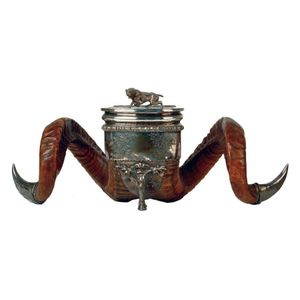Victorian Scottish Double Ram's Horn Snuff Mull
A large and impressive Victorian period Scottish double ram's Horn table snuff mull, with Walker & Hall silver plated mounts, including horn tip terminals and a central large oval snuff receptacle with stag's head, foot and hunting dog finial, complete with original internal tamper. Width 53 cm, height 20 cm
You must be a subscriber, and be logged in to view price and dealer details.
Subscribe Now to view actual auction price for this item
When you subscribe, you have the option of setting the currency in which to display prices to $Au, $US, $NZ or Stg.
This item has been sold, and the description, image and price are for reference purposes only.
- Victorian Period - The Victorian period of furniture and decorative arts design covers the reign of Queen Victoria from 1837 to 1901. There was not one dominant style of furniture in the Victorian period. Designers used and modified many historical styles such as Gothic, Tudor, Elizabethan, English Rococo, Neoclassical and others, although use of some styles, such as English Rococo and Gothic tended to dominate the furniture manufacture of the period.
The Victorian period was preceded by the Regency and William IV periods, and followed by the Edwardian period, named for Edward VII (1841 ? 1910) who was King of the United Kingdom and the British Dominions and Emperor of India for the brief period from 1901 until his death in 1910. - Horn - Full horns were used for making drinking vessels and powder horns. A number of larger horns or antlers could be combined together to make furniture and decorative items such as chairs and lamps.
As a material, horn was formerly used in all types of objects such as snuff boxes, lanterns, musical instruments, items for personal grooming, cutlery handles, walking sticks. Some items of horn are finely decorated with silver or mounted in silver. - Finial - An architectural decoration, found on the upper parts of of an object. On furniture they are usually found on pediments, canopies and shelf supports. On smaller ceramic or silver items, such as spoons, they may decorate the top of the item itself, or the lid or cover where they provide a useful handle for removal.
Finials have a variety of shapes and forms. They may be urn-shaped, baluster shaped round or spiral, but usually taper into an upper point. Many real life shapes may also be used as finials, such as pineapples, berries, pinecones, buds, lotus and acorns. Sometimes animals such as a lion are depicted, or fish and dolphins.
This item has been included into following indexes:
Visually similar items

Lechwe antelope horns. 25 x 26 cm
Sold by
in
for
You can display prices in $Au, $US, $NZ or Stg.

Tahr horns, inscribed 'Shot Murchison 1963', 25 x 12 cm
Sold by
in
for
You can display prices in $Au, $US, $NZ or Stg.

Two middle Sepik figural suspension hooks, the largest, 94 cm high
Sold by
in
for
You can display prices in $Au, $US, $NZ or Stg.

A silver-plated wine bucket, marked: champagne Montebello, 20 cm high
Sold by
in
for
You can display prices in $Au, $US, $NZ or Stg.
